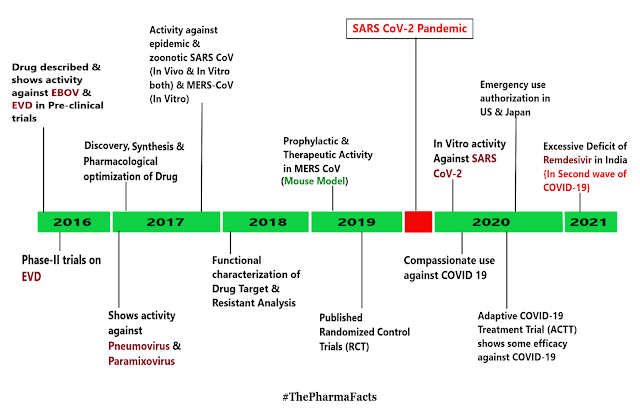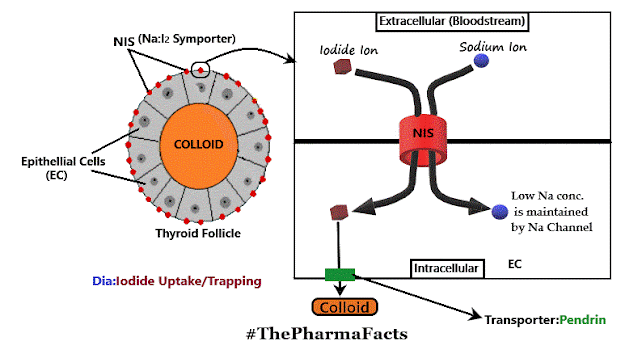Thyroid Harmones: II
Regulation of Secretion:
-Thyroid hormone secretion is controlled by Anterior Pituitary gland via thyrotropin or TSH.
-TSH is stimulated by TRH which is secreted from Hypothalamus.
-Somatostatin from Hypothalamus, T3 & T4 inhibits Anterior Pituitary gland directly from releasing TSH while only T3 & T4 inhibits Hypothalamus to release TRH.
-The action of TRH on Pituitary Gland & TSH on Thyroid gland is mediated by enhanced cAMP synthesis.
-Higher concentration of TSH acts via IP3/DAG Pathway & Mediate intracellular calcium pathway in thyroid cell.
Mechanism of Action:
-Thyroid hormones bind to ligand-binding domain of thyroid hormone receptor (TR) & and it heterodimerizes with retinoid X receptor (RXR).
-Then it undergoes conformational changes releasing 'corepressor' & binding with 'coactivator'.
-This induces gene transcription followed by Production of specific m-RNA & thus specific protein synthesis is done which is used in various metabolic and anatomic effects.
Relationship between T3 & T4:
-Secretion: T4 > T3 ( but in iodine deficiency this difference gets reduced).
-Circulation: T4 > T3 ( scenes T4 bounds to plasma proteins 15 times more tightly than T3).
-Potency: T3 > T4 (5 times).
-Action: T3 > T4 ( Peak action of T3 in 1-2 days while T4 is in 6-8 days).
-T3 is more avidly bind to Nuclear receptors, unlike T4.
-T3 causes gene transcription, unlike T4.
-About ⅓rd of T4 is converted into T3 in thyroid cells liver-kidney by D1 (iodothyronine deiodinase type 1).
-T3 is generated within the target cells ( like skeletal muscles, heart, brain, pituitary gland) with the help of D2 (iodothyronine deiodinase type 2).
-T3 is main active hormone and T4 is type of transport hormone which function as Pro-hormone to T3
-T4 may produce some non-genomic actions except gene expression
Preparations:
-L thyroxine sodium
-T3 / Liothyronine
Pharmacokinetics & Interactions: (L-thyroxine sodium)
-oral bioavailability:
~75% [food alters its absorption & hence this drug is taken before meal or in empty stomach]
Severe hypothyroidism can reduce oral absorption
Sucralfate, iron, calcium & proton pump inhibitors also reduce its oral absorption
- CYP3A4 inducers like Rifampin, Phenytoin, Carbamazepine accelerate metabolism of T4 therefore enhancement of dose of thyroid drug is mandatory
[Note- L-thyroxine is preferred over T3 because of more sustained & uniform action as well as lower risk of cardiac arrhythmias]
Uses:
-the most important role is in replacement therapy in deficiency states such as:
1)Cretinism
-due to,
i) failure of thyroid gland development
ii) defect in thyroid hormone synthesis (sporadic cretinism)
iii) extreme iodine deficiency (endemic cretinism)
-treatment: 8-12 μg/kg thyroxine daily should start as early as possible (because mental retardation which has already ensued is only partially reversible)
2)Adult Hypothyroidism (Myxoedema):
-commonest endocrine disorder due to autoimmune thyroiditis or thyroidectomy
-important drug that can cause hypothyroidism ¹³¹I, iodides, lithium, amiodarone (beta-blockers)
-treatment: L-thyroxine with low dose 50 μg/day at starting & then increase in every 2-3 weeks ab to 100-200 μg/day & further doses are adjusted at 4-6 weeks intervals (dose increment is mandatory in pregnancy)
-Doses are adjusted according to clinical response and serum TSH levels
3) Myxoedema Coma:
-characterized by mental deterioration due to hypothyroidism hence, rapid thyroid replacement is crucial
-Treatment: Liothyronine acts faster but the risk in patients with arrhythmias angina Still it is recommended with 10 μg/8 hour in younger patients OR L-thyroxine 200-500 μg IV followed by 100 μg IV OD till oral therapy can be instituted
4)Non-toxic Goitre:
-causes due to iodine deficiency
-it may be,
i) Endemic (i.e. belongs to particular people of particular region) due to iodine deficiency which is emphasize by calcium present in water, food or milk
ii) Sporadic (i.e. occasionally seen diseases within particular conditions) due to the defect in hormone synthesis
-in both cases deficiency of thyroid hormone synthesis leads to excess TSH which causes thyroid enlargement (i.e.Goitre)
-treatment: non toxic goitre and cretinism due to iodine deficiency in pregnant women can be preventable by daily injection of 150-200 μg Iodine & sometimes T4 also given despite no open hyperthyroidism
5)Thyroid Nodules (Tumour):
-treatment:
i)benign functioning rigress when TSH is suppressed by T4 therapy
ii) non functional nodule doors are non-responsive to TSH and associated with low TSH levels do not respond to levothyroxine therefore shouldn't treated with levothyroxine
[Note-Therapy should be stopped if nodule size is not decreases within 6 months or when it stops regressing after the initial response]
6)Papillary Carcinoma of Thyroid:
-type of cancer which is often responsive to TSH
-treatment:in non removable cases full dose of T4 suppress endogenous TSH production and may induce temporary regression(back to normal)
7)Empirical Uses:
-refractory anaemia
-mental depression
-menstrual disorders (infertility is not corrected by usual treatment)
-chronic, non-healing ulcer
-obstinate constipation (severe form)
Thyroid Inhibitors:
-use to lower the functional capacity of hyperactive thyroid gland
-Classification:
1) Antithyroid Drugs/Thioamides
2) Ionic Inhibitors
3) Iodides
4) Radioactive Iodine
1) Thioamides:
-inhibit thyroid hormone synthesis
-this drug binds to the thyroid peroxidase & prevent the oxidation of iodine and iodo-tyrosyl residues, thereby;
i) inhibition of iodine action of tyrosine residues in thyroid gland
ii) inhibition of coupling of iodo-tyrosine residues to T3 & T4
-first action is slower then second action in lower dose of antithyroid drugs
-thus, thyroid colloid is depleted over time and blood levels of T3 or T4 are progressively lowered
-these drugs do not interfere with trapping, peripheral conversion (EXCEPT-propylthiouracil which causes inhibit peripheral conversion of T4 to T3) and they also don't cause goitre
Pharmacokinetics:
i) quickly absorbed orally, widely distributed in body, enters in milk and may cross placenta
ii) metabolized in liver, excreted through kidney as urine
iii) effect of single dose lasts longer than would be expected from plasma t½ of these drugs
-Adverse Effects:
i) Reversible hypothyroidism occurs due to over treatment
ii) Intolerance
iii) Skin rashes
iv) Joint pain (most important and common)
v) Loss or graying of hairs
vi) Infrequent liver damage
vii)Serious Adverse effect-Agranulocytosis (very rare & reversible)
-Examples:
i) Propylthiouracil
ii) Methemazole
iii) Carbimazole
-Doses:
i) Propylthiouracil: 50-150 mg TDS followed by 25-50 mg BDS/TDS
ii) Methemazole: 5-10 mg TDS initially maintain by 5-15 mg daily in 1-2 divided doses
iii) Carbimazole:(more commonly used in India) 5-15 mg TDS initially, maintain by 2.5-10 mg daily in 1-2 divided doses
-Uses:
i)Control Thyrotoxicosis (excessive secretion of thyroid hormones) in Grave's disease & toxic nodular goitre
ii)Before thyroidectomy carbimazole use to achieve euthyroidism
iii)Propylthiouracil is used in thyroid storm as well
2) Ionic Inhibitors:
-inhibit uptake of iodide by NIS
-Examples:
i) Perchlorates (highest potency)
ii) Thiocyanates
iii) Nitrates (lowest potency)
-Perchlorates:
*10 times more potent than thiocyanate in blocking NIS
*Produce rashes, fever, aplastic anaemia, agranulocytosis
-Thiocyanates: causes liver, kidney, bone marrow & brain toxicity
-Nitrates:
*Very weak in blocking in NIS then both of the above
*They are toxic & not in clinical use
3) Iodine & Iodides:
-Though iodine is constituent of TH it is fastest acting thyroid inhibitor
-excess iodine inhibits its own transport in thyroid cells by interfering with expression of an NIS on the cell membrane
-it weakens TSH & cAMP induced thyroid stimulation
-excess iodide rapidly & briefly interferes with iodination of thyroid and thyronil residue of thyroglobulin resulting in reduced T3 & T4 synthesis known as "Wolff-Chaikoff effect"
-however, within few days the gland is capes from this effect and hormone synthesis resumes
-Pharmacokinetics: oral absorption is optimum and metabolized in intestine
-Adverse Effects:
i)Acute Reactions-swelling of lips &eyelids, angioedema of larynx, fever, joint pain, thrombocytopenia, swollen lymph nodes
ii) Chronic Reactions-(Iodism) inflammation of mucous membrane, salivation, rhinorrhea (running nose), sneezing, lacrimation, burning sensation in mouth, headache, rashes, GIT problems
-Examples:
i) Lugol's Solution- 5% Iodine in 10% potassium iodide
ii) Sodium/Potassium Iodide
-Doses:
i) Lugol's Solution: 5-10 drops/day
ii) Sodium/Potassium Iodide: 100-300 mg/day(therapeutic) or 5-10 mg/day(prophylactic) for endemic goitre
-Uses:
i)Preoperative preparation for thyroidectomy in Grave's disease & thyroid storm
ii)Prophylaxis (treatment given or action taken to avoid disease) of endemic goitre
iii) Antiseptic Uses
4) Radioactive Iodine:
-¹³¹I having medical importance
-its chemical behaviour is similar to stable isotope of Iodine
-t½ is 8 days
-it emits X-rays & β-particles
-radioactive iodine is administered as sodium salt of ¹³¹I dissolved in water and taken orally
-Diagnostic use of ¹³¹I: 25-100 μ curie ; counting & scanning is done at intervals (no damage at this dose)
- Therapeutic use of ¹³¹I: 3-6 m curie where 20-40% patients required one or more repeat doses for treatment of Graves disease at mentioned dose or treatment of multi-nodular goitre at more dose than mentioned
-Advantages:
i) Simple, convenient & inexpensive treatment
ii) No surgical risk, scar or injury to parathyroid glands
iii) Once hyperthyroid is controlled, cure is permanent
-Disadvantages:
i)Hypothyroidism- 5-10% patients of Grave's disease treated with ¹³¹I suffer from hypothyroidism [50% patients require supplementary thyroxine treatment]
ii)Long latent period of response i.e. existing but not noticeable
iii)Contraindicated in pregnancy
iv)Not suitable for any patients
[Note-¹³¹I is given as palliative therapy after thyroidectomy]
*β-Adrenergic blockers: Propranolol & other nonselective β-blockers have emerged as an important therapy to rapidly reduce manifestation of thyrotoxicosis that are due to sympathetic overactivity
*Thyroid Storm (Thyrotoxis Crisis):
- Propranolol: 1-2 mg slow IV followed by 40-80 mg oral/6 hours
- Propylthiouracil: 200-500mg oral/hours
- Diltiazem: 60-120 mg BD oral (if propranolol is contraindicated in trachycardia) for treatment of hyperthyroidism
- Dexamethasone (glucocorticoid) injection: large dose
- Paracetamol
- Hydrocortisone: 100 mg IV 8 hourly
- Iopanoic acid: 0.5-1 g oral OD or Ipodate (iodine containing radiocontrast media)







Comments
Post a Comment
If you have any query or If you like the post,Please let me know.